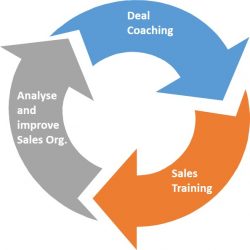A lot of literature is focusing on the question How to say no to a business partner. It centers around the technical aspects to stay polite, clear, and not to hurt a customer by such a negative message. This post will look at another aspect of the no message – why this is important for the customer relationship. Actually, I believe, a customer relationship is not complete until a first important No has been said.
Especially during the early stages of sales (see here on the sales cycle), when requirements and scope are discussed, sellers tend to tell customer a full Yes as answer to all their inquiries (Can you do X, can you reschedule the delivery, will it be possible to …). The motivation behind this is quite clear – the seller is afraid to lose out against the competition in case he can’t fulfil a certain requirement. While this is easy to understand, this behaviour has some consequences:
- The seller overcommits, which will lead to issues later on during delivery. It is a typical situation when a project starts, and the delivery team slowly figures out what all has been promised to the customer during the sales process. Typically, this is of course preempted by the project manager by overestimating a bit, in order to compensate for the additional work arising for this kind of surprises.
- The customer can lose his trust in the team. Especially in a case when all other competitors have declined a requirements, and only you have confirmed that this is in scope (and in price) customers will get suspicious. Sometimes, they will actually test the seller by stating requirements that they know as not doable. In case a seller finds himself in such a situation, well, it can be quite embarrassing…
- You will after some time lose the respect of the customer if you always say yes – only servants never decline a request. A partner who is talking to a customer on ‘eye level’ (in the role of a trusted advisor) will always tell the customer politely but firmly what is possible and what will not work. Of course it is important that you tell the customer exactly the reason of your no, and also, what it takes to come to a yes, or how a better alternative solution could look like.
A possible dialogue can look like this:
Customer: When we last discussed, we talked about the new menu structure of the application. During our review we came up with some new options that need to be integrated. I’m sure that this will not be a problem for you.
Seller: This will for sure be possible to get implemented from a technical point of view. When looking at the functional implication of what you propose, we see that this will change the functionality of the application quite a lot – it will mean more effort on our side. I’ll get back to you with the exact estimates from the project team, and then we can discuss how to either change the budget or cut off scope in another area of the project.
With such a statement, the seller signals that it is possible to execute the requirement, but that this will have a price.
Therefore, during the early phase of a sales cycle, you should carefully set the first No message to the customer, clearly showing that you are a partner and not a supplier, and that you will honestly give feedback, even it is not always a yes to the customer.
Different customers will of course react quite different to you saying No – some will not take it well, telling you that as a supplier your role is to accept the requirements and implement them. Some might also challenge you or start putting pressure on you, either because they do not want to accept a no from you, or because they want to test you. Some will also escalate to your supervisor, thereby also testing if you are in line with your management, or if they can get a better answer from them (in which case your role as a seller will be in trouble)
Therefore it is also important to chose the occasion – it needs to be an important question, but also not a deal breaker. Then take the opportunity to learn how this customer reacts to a No, so that when the really important questions are discussed later in the sales cycle (up to the final negations) you know how your customer will react (and the customer will also know how you will react, and that your No will have a reason and will be in a constructive way). Overall, coming to the first important No is a good opportunity that shows the value of Deal Coaching
Your comments – or real world examples of what worked and what not?

